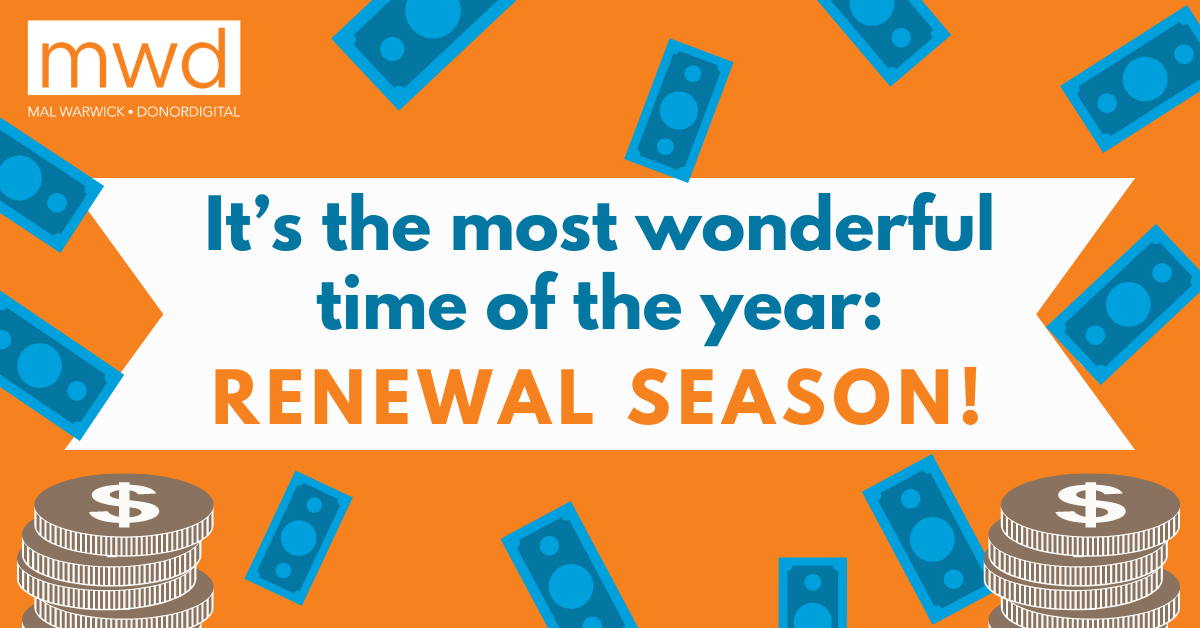
While many of us in the industry thought the COVID pandemic would hurt specific sectors not connected to direct relief, the Blackbaud Index recently reported exciting growth in both new donors and overall revenue in 2020. These increases in donor volume are across the board, in nearly every sector!
So, what do nonprofits like yours do now? How do you retain all those new donors you brought on in 2020, this year?
Well, leverage your renewal series and offers, of course!
Truth be told, I’m a RENEWAL NERD. I could write a whole book on the efforts of renewing donors. Renewal offers are the “bread and butter” of one-time gift grassroots donor fundraising. Even across channels…from direct mail to email, to mobile texting, to digital advertising…the word “renew” is powerful. While not all organizations work to renew donors at the start of the calendar year, many do, which is why it’s a great time to lift up some renewal best practices and testing ideas to help with both first-year and multi-year donor retention.
- Integrate channels and let direct mail lead. You might have a long-standing renewal mail series in place. Now is the time to create a robust multi-channel campaign where you are certain to grab the attention of your donors through multiple channels that echo the same promotions and offers. These other channels will lift the performance of direct mail or help drive donors to your website for a more immediate place to give. This is not the time to carve out online-only donors in the mail. Allow them to receive the mail and make sure you have homepage promotions and renewal-specific vanity links in place to reel them in! Make sure your donation form is dynamic and serves asks using the donor’s giving history being used in the mail. Too high an online ask could lead to a suppressed response, while too low of an ask could downgrade donor value.
- Evaluate (and test) the order of your direct mail renewal series. Renewal programs should have an incredibly high ROI. You can achieve this by incorporating super-cheap renewal package concepts that work. It is common for a “Renewal 1” (your best performer) to be a more expensive package—like a member/supporter card. But after that, you want to ensure that your later renewals are still doing the job. Evaluate each mailings’ performance individually and test higher-performing packages earlier in the series. Do this annually! And don’t be nervous to mail your highest performing packages again later in the series. If your expensive Renewal 1 is your best performer, order additional quantity to harness economies of scale and mail it again 6 months later!
- Set up automation to serve triggered renewal emails. We all know there are two types of donors—ones that need 6 renewals to nudge them to give annually, and ones that know the exact month and date they renew each year. Either way, save money by renewing annual donors early online by setting up triggered emails when donors are about to lapse. Make sure to use institutional, evergreen messaging that will make sense regardless of what is happening in the news.
- Use Renewals to let the donor know you know Renewals are a great place to use personalization both offline and online. Test including more of their donor record information in your renewal correspondences. For direct mail, try a “giving history box” illustrating the donation amount of their renewal donation of the last few years. For email, try a “donor verification” concept that asks donors to confirm their postal address and phone number (with a way to opt-in to texts, of course) and position it as customer service outreach. After the donor confirms their personal information on a special landing page, they land on a renewal offer contribution page. (One caveat to including donor record information is you need to be confident in your database’s accuracy!)
- Keep your Renewal Messaging Mission-Driven & Brief. Renewal copy should be the easiest copy you create. Renewal copy should be intentional, get right to the point, and be explicit about where the donor’s contribution will be spent. Really connect the dots for the donor so they know where their annual support is going and exactly what they are supporting. It should always include the word “renew.”
- Consider expanding your audience. I admit some programs are more aggressive at renewing than others and you should always test any changes you incorporate into your renewal series to see what works for your donors. With that said, why allow donors to lapse in the first place? Test targeting more recent donors to get them to renew early (like maybe you target donors who haven’t given a gift in 9+ months rather than waiting until they are 12+ months out from their gift). And on the flip side, consider suppressing any donors who have a history of NOT responding to renewals but responding to other offers. If you can identify “chronic renewal non-responders,” then don’t target them with a renewal offer. And for more lapsed donors, test a renewal version of your long-standing mail acquisition control to see if you can renew them as they were acquired. If they were inspired by your acquisition package once, they may retain that way!
- Test renewal language in your strongest appeals. If you don’t have a long renewal series, try testing renewal language in your appeal series to donors beyond 13 months recency. You can try peppering renewal language in your cornerstone campaigns to see if it generates a lift in response. Did I mention the power of the word “renew”?
- Include a sustainer offer as a way to renew. Converting one-time gift donors to sustainers is the ultimate way to retain a donor year-over-year. We now live in an online subscription culture. Music, TV, journalism, food…it feels like nearly everything in life requires a monthly membership now. As humans we’ve become much more comfortable with ongoing monthly charges and supporting what is important to a donor should be no different. Always provide an opportunity on your direct mail reply device and donation form for donors to choose a monthly option during renewal season. You’ll be surprised how many of your donors will choose to opt-in—and those that opt-in to monthly giving during renewal season are often some of the most loyal sustainers on your file!
- Include your mid-level and even major donors. You read that right. Obviously, if a major donor is working with a major donor gift officer, that’s not the right audience. But including higher-value donors in your super-cheap-yet-effective renewal offers will help skyrocket your ROI. Don’t protect them; they need to be reminded when they haven’t given too. And retention of these donors is crucial for your overall revenue goals. Why would you spend the money to send 6 renewals to a $25 donor and none to a $1,000 donor?
- Lower the ask as a “special deal.” For those fickle grassroots donors who are two years or more out from their last gift, try lowering the ask which lowers the barrier to giving. “You’ve been a member since year 201X, renew now at just $25!” At this point, you’d rather have them stay with you, even at a lower price point, then fall off your file. You’ll end up spending more money to renew them the longer they hold out. Get them back now and work to bring them up the giving ladder in your more exciting cornerstone campaigns.
I hope these ideas provide some inspiration as you develop your renewal strategies this year. I wish you higher donor retention in 2021!

Tiffany Reed, (she/her), Vice President, has over 18 years of direct response experience and is an expert in both non-profit and political fundraising. At MWD, she is leading multi-channel, integrated client teams with a focus on donor retention and improving ROI for grassroots and mid-level direct marketing programs.
![[ Facebook ]](/img/connect-facebook.png)
![[ Twitter ]](/img/connect-twitter.png)